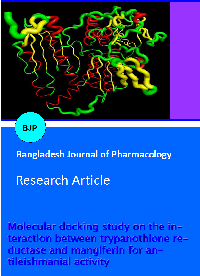Molecular docking study on the interaction between trypanothione reductase and mangiferin for antileishmanial activity
DOI:
https://doi.org/10.3329/bjp.v8i1.13034Keywords:
Antileishmanial, Autodock, Leishmania infantum, Mangiferin, Trypanothione reductaseAbstract
Mangiferin was found to bind at active site of Leishmania infantum Try R with lowest binding energy and RMSD values to be -9.16 Kcal/Mol and 1.98 respectively. Docking analysis of Try R with ligand enabled us to identify specific residues viz. Phe-203, Glu-202, Asp-218, Pro-336, Try-221 and Phe-270, within the Try R binding pocket to play an important role in ligand binding affinity. The availability of Try R built model, together with insights gained from docking analysis will promote the rational design of potent and selective Try R inhibitor as antileishmanial therapeutic. The study contributes towards understanding mechanism of antileshmanial effect of the mangiferin. We have surveyed the available literature to summarize the inhibition of Try R activity of this natural compound. Thus on the basis of our in silico studies we hypothesize that this compound into mangiferin can be inhibitory effect on against leishmaniasis.
Downloads
331
216 Read
26
References
Bhowmik A, Ali Khan L, Akhter M, Rokeya B. Studies on the antidiabetic effects of Mangifera indica stem-barks and leaves on nondiabetic, type 1 and type 2 diabetic model rats. Bangladesh J Pharmacol. 2009; 4: 110-14.
Bikadi Z, Hazai E. Application of the PM6 semi-empirical method to modeling proteins enhances docking accuracy of AutoDock. J Cheminform. 2009; 11: 1-15.
Dar A, Faizi S, Naqvi S, Roome T, Zikr-ur-Rehman S, et al. Analgesic and antioxidant activity of mangiferin and its derivatives: The structure activity relationship. Biol Pharm Bull. 2005; 28: 596-600.
Duang X, Wang Q, Zhou X, Huang D. Mangiferin: A possible strategy for periodontal disease to therapy. Medical Hypotheses. 2011; 76: 48688.
Dumas C, Ouellette M, Tovar J, Cunningham ML, Fairlamb AH, Tamar S, Olivier M, Papadopoulouet B. Disruption of the trypanothione reductase gene of Leishmania decrease its ability to survive oxidative stress in macrophages. EMBO J. 1997; 16: 259098.
Fairlamb AH, Cerami A. Metabolism and function of trypanothione in the kinetoplastida. Ann Rev Microbiol. 1992; 46: 695-729.
Ghosal S, Rao G, Saravanan V, Misra S, Rana D. A plausible chemical mechanism of the bioactivities of mangiferin. Indian J Chem B Org. 1996; 35B: 561-66.
Guha S, Ghosal S, Chattopadhyay U. Antitumor, immune-modulatory and anti-HIV effect of mangiferin, a naturally occurring glucosylxanthone. Chemotherapy 1996; 42: 443-51.
Miliauskas G, Venskutonis PR, Van Beek TA. Screening of radical scavenging activity of some medicinal and aromatic plant extracts. Food Chem. 2004; 58: 231-37.
Murunganandan S, Lal J, Gupta PK. Immunotherapeutic effects of mangiferin mediated by the inhibition of oxidative stress to activated lymphocytes, neutrophils and macrophages. Toxicology 2005; 215: 57-68.
Myler PJ, Fasel N. Leishmania: After the genome. Norfolk, UK, Caister Academic Press, 2008.
Niu Y, Li S, Na L, Feng R, Liu L, Ying L, Changho S. Mangiferin decreases plasma free fatty acids through promoting its catabolism in liver by activation of AMPK. PLoS ONE. 2012; 7: 1-8.
Oprea TI, Davis AM, Teague SJ, Leeson PD. Is there a Difference between Leads and Drugs? A historical perspective. J Chem Inf Comput Sci. 2001; 41: 30815.
Shukla AK, Singh BK, Patra S, Dubey VK. Rational approaches for drug designing against leishmaniasis. Appl Biochem Biotechnol. 2010; 160: 220818.
Tempone AG, Borboremab SE, de Andrade HF, Amorim Gualda NC, Yogi A, Salerno Carvalho C, Bachiega D, Lupo FN, Bonotto SV, Fischer DCH. Antiprotozoal activity of Brazilian plant extracts from isoquinoline alkaloid-producing families. Phytomedicine 2005; 12: 38290.
Tovar J, Cunningham ML, Smith AC, Croft SL, Fairlamb AH. Down-regulation of Leishmania donovani trypanothione reductase by heterologous expression of a trans-dominant mutant homologue: Effect on parasite intracellular survival. Proc Natl Acad Sci. 1998; 95: 531116.
Zhang HY. AM1 calculation study of scavenging effect of Chinonin on free radicals. Acta Pharmacol. Sin. 1999; 20: 555-58.

Published
How to Cite
Issue
Section
License
Authors who publish with this journal agree to the following terms:
- Authors retain copyright and grant the journal right of first publication with the work simultaneously licensed under a Creative Commons Attribution License that allows others to share the work with an acknowledgement of the work's authorship and initial publication in this journal.
- Authors are able to enter into separate, additional contractual arrangements for the non-exclusive distribution of the journal's published version of the work (e.g., post it to an institutional repository or publish it in a book), with an acknowledgement of its initial publication in this journal.
- Authors are permitted and encouraged to post their work online (e.g., in institutional repositories or on their website) prior to and during the submission process, as it can lead to productive exchanges, as well as earlier and greater citation of published work (See The Effect of Open Access).
